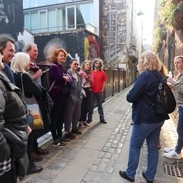Who do I tell?
VisitBritain/Pinzutu

Who is your target audience?
There are many signs that consumers are changing. An increasing awareness of, and concern for, the planet’s health is everywhere: but there is a lot of information and the issues can be quite complex, so it can get quite confusing.
Value for money
Since the COVID-19 pandemic and the subsequent economic squeeze, consumer buying patterns have changed – people put more value on authentic experiences and have more concern for environmental issues than ever before. But as their spending power may have decreased, it’s important they see value for their money.
When it comes to choosing sustainable products, most consumers want easy choices, but are aware there is a lot of over-claiming of their environmental credentials around – something known as ‘greenwashing’. It’s not surprising consumers are confused about what’s best to do and what really does make a difference.
Broaden your reach
It is unlikely that your business will survive if you only target the small percentage of conscientious consumers out there who are directly influenced by the good you do for people and the planet.
You need to think about how to tempt those consumers who may be interested in sustainability, but probably put other considerations first. This group might notice a product or service because of its sustainability credentials, but will only go on to buy a sustainable product if they like it better than other products on offer.
There is a market out there that is cynical, and you may fear putting them off. The key is to not make sustainability appear as if other aspects, such as service, comfort, quality and others, have had to be compromised.
Customers can be divided into three main groups
1. “I care for the environment and society”
These people are knowledgeable, willing to do research and pay extra for sustainable products and services.
2. “Not bothered”
These people can be cynical, travel to relax or for work, expect that the environmental basics are covered. They will not prioritise this or pay extra for these.
3. “What’s in it for me?”
This group seeks different experiences and are willing to buy ‘sustainability’ if there is a clear, personal benefit.
The good news is, that the number of consumers in groups 1 and 3 are rapidly growing. Group 2, however, still reflects the views of a large chunk of the market.
Your communication needs to reflect who you are talking to. For example, if you wanted your customers to travel by public transport, you might tell the first group that it would reduce their CO2 emissions. You might tell the second group that it would be more comfortable and enjoyable, and the third group that it would be cheaper and more efficient.
In this way, you can use a variety of messages to attract people from each of the different consumer types, therefore broadening your reach.
More about different groups of customers
I care for the environment and people"
Show them the difference you make – substantiate your claims
These conscientious consumers actively seek sustainable experiences as a continuation of their lifestyle at home. They will research widely before travelling, are knowledgeable about the places they visit and the things they want to do. They claim to be willing to pay more for a product that makes a difference.
Because they are knowledgeable and conscientious, they will tell the world if you are found to be greenwashing - claiming to be sustainable on the back of tokenistic actions that make little difference. So, substantiate your claims with detailed evidence of what you do and the impact it has.
The trouble is, only about 10 to 15% of consumers think this way. That’s unlikely to be enough people to target if you want your business to survive.
The trick is to capture this market without alienating less-conscientious consumers.
All these statistics sound great! But there is a gap between what people say and what people do.
Make sustainability evident but not threatening
We differentiate ourselves without sounding worthy.”
VisitBritain/The Green House Hotel, Bournemouth

What we do
On the face of it our hotel is a beautiful, restored Victorian villa. From the outset it was important for us to convey that luxury and sustainability could go hand-in-hand. Our website provides information about all the sustainability practices we have put in place.
How we tell
We target discerning customers and those who are looking for responsible hotels – “serious about luxury, serious about sustainability”. The hotel and wedding markets are crowded, so emphasising sustainability makes this our unique selling point.
We use photos to show that the hotel offers luxury, and the text to speak about our sustainability values and reassure that being sustainable means that we care about our customer experience. We tell customers to dig a little deeper to find the sustainability evidence, and emphasise the external credibility of our work with the awards and rave reviews we receive.
We use personal messages to show the human connection of staying in a green hotel.
“The last thing we want to do is lecture you about our environmental credentials. You won’t get any sermons at our luxury and boutique hotel front desk – just a warm, friendly and relaxed welcome,” says Olivia.
Our top tip
Be transparent and allow customers to know about you, so you can explain your values and show them you don’t compromise on quality or the guest experience.
“What’s in it for me?”
What’s in it for me?"
Reassure them that sustainability equals quality, and gives them a better experience.
The “what’s in it for me?” group makes up the majority of consumers. They are aware of the issues, but don’t go out of their way to act. They won’t look for sustainability information but they respond well to messages that show they can easily ‘do their bit’ or get a better product or service that happens to be sustainable.
These travellers will book the brands they already know through their usual channels. Habit and convenience play a more important part in how they choose travel, leisure and tourism.
Price, location, convenience and brand still come first. But when all of these are equal, sustainability values and actions can differentiate a product.
Sustainability could be everywhere, from preserving the traditional architecture of your business to having solar panels. It can include proudly showing the authenticity and uniqueness of your sustainable practices to providing information about local activities and walks. But it is important to show not only your practices, but also how customers can benefit.
“Not bothered”
Not bothered"
Show them that you care, unobtrusively
Many travellers just want to switch off. They have earned their right to relax or are too busy to care. They probably already expect you to be acting sustainably because of your size or location, or they simply don’t want to think about it.
This group is quite cynical. Any claims of sustainably needs to be substantiated with external verification. If only some of your actions are sustainable, it is less risky to miss the ‘s’ word out than to have to explain the individual things you do instead.
Sustainability actions will need to happen behind the scenes and your communication should focus on how you make things easier for your customers. Also, try to use different communication methods to attract a variety of people that could help you influence those who don’t care about your sustainable actions.
Educational entertainment
We explain how sustainability improves your life, while having fun at the same time."
Jim Johnston/WWT

What we do
Wetlands are important because they are a primary source of drinking water for people and wildlife. Most of our nine wetland centres across the UK have treatment systems to preserve the wetlands and their wildlife. The centres also provide a nice day out for people to enjoy getting close to nature.
How we tell
We realise most people aren’t aware of the impacts of their actions, so we use clear, explanatory and engaging messages on site to help people understand through practical experience.
For example, our toilet message tells customers the importance of treating water for humans and wildlife alike with the “What happens to my water?” story. We explain the workings of on-site systems used to treat water and how this same water is enjoyed by the wildlife that they can see and feed. Linking the story with the toilet they have just used increases the sense of ownership and the fact that daily actions have an impact.
It’s not about doom and gloom: visitors feeding rare geese and enjoying a pleasant day out reinforces the positive message of environmental preservation.
Our top tip
Put across attractive, visual messages for an active target audience and engage them by offering practical experiences. It’s better to put the messages right where the action is happening, and to explain the outcomes, so the customers can see their role during the process.
“We must follow green procurement requirements”
We must follow green procurement requirements”
Corporate clients who book events, tourism or hospitality services such as conference venues, travel or accommodation, are guided by their corporate purchasing policies. These policies increasingly require companies to prove how sustainable they are before they can become a preferred supplier.
Corporate Social Responsibility
A report called The State of Corporate Social Responsibility (CRS) from Meeting Professionals International (MPI) states:
‘Adoption of CSR policies and initiatives within top-ranked, multinational companies has generated an expectation of CSR practice in all industries and at all levels.’
Request for Proposal
A Request for Proposal (RfP) is a document sent by companies to potential suppliers at the beginning of a procurement process for goods or services. RfP are used to gather information from different suppliers to assess competing bids. Increasingly, RfP include sustainability policies, carbon emissions, employee engagement, training, effect on local communities and human rights issues. The RfP relate to what happens inside the tourism business itself, but also to how their policies are cascaded down to their suppliers.
However, there is no standardisation in what these RfP ask or how, or whether the questions refer to the overall company or an individual property/business unit. This is in part because there is no standardisation on how to evaluate most impacts. This is causing confusion: the hotel sector in particular is increasingly spending time completing more forms on sustainability practices for different potential clients.
Sustainability criteria are necessary to tender, but currently aren’t a major purchasing decision-maker for corporate clients. Most buyers give it some consideration rather than an actual score. However, its importance is growing year on year.
The outcome is that your business will be increasingly expected to demonstrate how you care for the environment and contribute to society as a pre-requisite to trade.
Get everybody involved
We get opinion leaders to do the marketing for us."

What we do
We are all volunteers and together we have transformed a former coal storage yard into an ‘entertain and educate’ local tourist attraction. Visitors find our rail history intriguing and they can explore and enjoy lovely walks while being able to study over 200 flora and fauna species.
How we tell
We have built relations with a number of companies and organisations that share our values. We encourage local and national leaders to organise ‘community team days’, so they can send their employees to help out. For example, we have received visits from the National Trust and Rotary International. When they come, they help us with work to improve our species’ habitats and we give presentations to inspire people to do good.
During these days we showcase our work and hope that it will motivate them to become members or to help promote what we do.
Thanks to these community days, people who weren’t previously interested in sustainability have learnt about us from well-known organisations, which is great marketing.
We have found this reinforces our more traditional communication methods such as the information on our website and in our centre. Opinion leaders tend to be very effective at predisposing the general public to consider us, even when they are not committed to sustainability. They introduce us at local events, and we take our brochures and talk to people directly. The relationship works really well.
Our top tip
Engage with opinion leaders who share your environmental values, so that they can convince less sustainably-committed people to participate. Others talking well about you is more convincing than your own printed materials.
Navigation
Contents:
Next:







